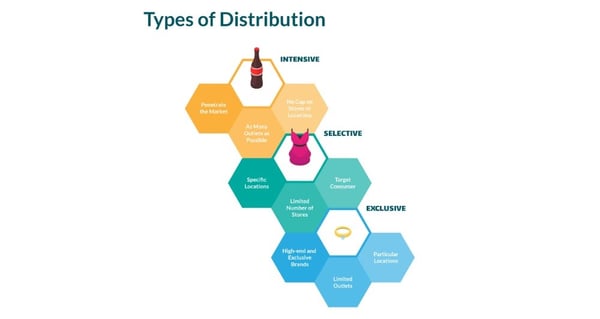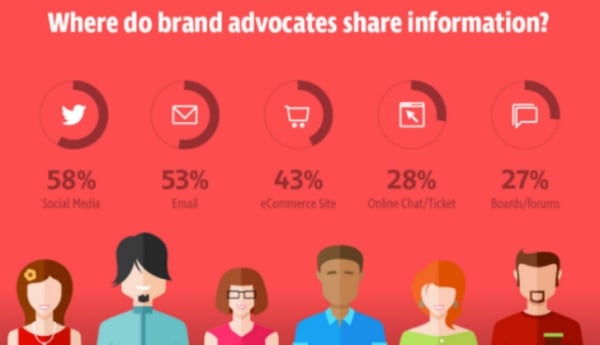Running a retail business feels more complicated today than ever before. To survive in a competitive market, brands have to outshine their competitors and reach their customers where they are. This can be a challenge — that is, if you don’t have an optimized distribution strategy.
.jpg)
Today, consumers expect to interact with brands via many channels. They want to buy in-store, via a company site, third-party platforms, and even social media. An optimized distribution strategy will help you figure out the right way to reach them, and in this article, we’ll guide you through how to do just that.
Read on to find out:
-
What a distribution strategy is.
Which types of strategy exist.
Why properly optimizing your strategy is essential.
How to create a plan that will help you win more sales.
What is distribution strategy?
Distribution strategy is how a business best places its goods and services in front of customers or end-users.
The principal aim of any retailer is to get their goods to the target market. Not only that, you must make them available in the manner they prefer to buy them, as seamlessly as possible. Your distribution strategy is how you reconcile all those necessities.

Your strategy is your plan to speed the connection between your offerings and their end-users. That’s whether they’re consumers, businesses, or a mixture of the two. There are many considerations to account for when defining a distribution strategy. The following are a handful of the most notable:
- Consumer needs and demands.
- The nature of your products and how they must get sold and used.
- Shipping considerations.
- Your direct competitors and how they serve customers.
- The customer experience you aim to give and how distribution options align with it.
- Your budget and the costs associated with different distribution channels.
First, let’s look at one of the fundamental building blocks of an optimized distribution strategy—those being distribution channels.
Distribution Channels
You might think distribution channels are self-explanatory. It’s the different places you sell your products, right? Wrong. That’s a common misconception. Your website, a third-party platform, or a physical store is not a distribution channel. However, each can form part of your distribution channel.
A distribution channel is a product's entire journey to get from you to its end-user. It could be that your store or website is all that’s involved. That’s the case if you’re direct to consumer (D2C) brand. You sell your lines straight to their end-users. Not all distribution channels are as straightforward, though.

Lots of channels, in fact, include intermediate steps between your firm and consumers. The principal players in such more complex chains are as follows:
- Producers – These are the manufacturers who make products or their constituent parts.
- Wholesalers – Firms specializing in broad distribution of products to multiple retailers.
- Retailers – Businesses that sell products to their end-users. Sales can happen online or offline.
- Consumers/End-Users – The final purchasers of an item. They’re buying it to use, not to sell on.
Your business can exist at different points of these channels. If you sell many different products, too, each may have their own channel. You may also utilize more than one - or even more than one type - even if you only provide one product line. That’s where three principal varieties of distribution strategy enter the picture.
Types of Distribution Strategy
An optimized sales distribution strategy is one tailored to your brand and customers. You don’t have to choose from a limited number of prescribed alternatives. There are, however, three categories into which most strategies fall:
1. Intensive Distribution Strategy
Many brands adopt this type of plan. It involves implementing as many different channels as possible for a given product. The most notable advantage is that this enhances market penetration for the product. It can be an expensive choice, however.
2. Selective Distribution Strategy
This strategy is when firms choose different channels for specific products or services. They might, for instance, only sell an item in a particular geographic area. Or they may restrict sales of product lines to only their website. The idea here is to match channels to consumer behavior and demand. That, thus, is more cost and time-efficient for the brand.
3. Exclusive Distribution Strategy
Companies may restrict the provision of some items even more. They could, for instance, use only one very narrow channel for a particular line. When brands use this tactic, they’re trying to stoke scarcity and thus demand. It’s how companies make products seem higher-end and more desirable.

Defining a distribution strategy is more complicated than choosing from those three options, of course. You must consider product characteristics and consumer demand. You also need to think about geographical and demographic differences in your target audience.
The best distribution strategies, too, account for and encompass other elements, such as:
- Content Marketing & SEO: How does this impact or align with different distribution channels?
- Advertising: Which ad types (online or off) best support your broader strategy?
- Business Operations & Tech: Could the best order management software make a direct channel a better option? Is your logistics good enough to reliably supply a retailer on the other side of the world?
- Brand Identity: Does it fit your brand’s positioning to have your products in every store under the sun? If you have a higher-end reputation, should availability be more limited?
Distribution Strategy Examples
1. Dawn Dish Soap: Intensive Distribution Strategy
Household cleaning products aim to position their product in almost every type of general store, meaning both direct and indirect outlets. Customers can buy their favorite dish soap online from wholesalers, curb-side pickup at their favorite grocery store (distributors), or in person as they run errands.

By using the intensive strategy, dish soap is available at:
- Grocery stores
- Convenience stores
- Ecommerce websites
2. Jeni’s Ice Cream: Selective Distribution Strategy
Ice cream is typically seen as another product sold using the intensive distribution strategy. Still, for smaller brands that aren’t sold in big box stores, Jeni’s has the opportunity to offer exclusive flavors and products depending on the location of its ice cream parlors — and now even through shipping.

This brand’s selective strategy is reflected in that for particular states or shop locations, exclusive merch like pint koozies, seasonal flavors, or limited edition flavors are only available in controlled ways and periods.
3. Local Pet-Sitting Service: Exclusive Distribution Strategy
Even more niche of a service offering, a small business running a pet-sitting service may only encompass a particular zip code or clientele. This business may only be advertised through word-of-mouth or flyers shared around a small town.
This strategy also works for a business like a pet sitter because pet owners may trust a single individual more than a chain pet hotel. The customers’ pets may get more attention and better care — displaying the value in exclusivity as owners will have more trust and build a closer relationship with the service provider over chains offering the same service.
Why an Optimized Distribution Strategy is Essential
The most successful companies are those who create a genuine connection with consumers. You can’t do that with a scattershot approach to distribution. You must tailor your strategy to those you wish to serve. That way, you ensure your target market gets the desired customer experience.
To deliver that experience, both customer satisfaction and loyalty will follow. Loyal customers are like gold dust for businesses. They spend more, and it costs less to keep them on board than to attract new ones. That’s why optimized distribution is essential.
On top of that, more of your customers will also become brand advocates. They’ll sing your praises to friends, relatives, colleagues, and more. You got them the products they wanted, when and how they wanted them, after all.

An optimized distribution strategy, then, can aid both customer retention and acquisition. Thus, winning you more sales in two distinct ways. How, though, can you create that kind of strategy?
Tips for Creating an Effective Distribution Strategy
1. Selecting the correct channels.
An integral part of your distribution strategy is your choice of channels. You must decide on the most efficient way of delivering products to your audience. Lean on as much customer data as you can find to answer these questions:
- How, when, and where do your customers prefer to shop?
- If you’re not the manufacturer, from where can you get your products?
- How much post-purchase support might end-users need? Would third-party retailers or providers be able to offer it?
- Do you need to explore different channels for particular products? Or in other geographical areas or territories?
Staying focused on your customers is always a good rule of thumb. When defining a distribution strategy, though, you should also consider your commercial goals. Your chosen channels must be viable as regards your budget and future plans.
For instance, you may find that consumers like to buy your kind of products directly online. That could suggest a direct channel where you sell through a dedicated online store. Say, however, that you’ve never dabbled with eCommerce before.
Starting to sell online is no small undertaking. There’s far more to it than designing a website, going line, and watching sales come in. You must promote your site and get traffic. What’s more, you have to get the logistics right for shipping and delivery.
If your brand doesn’t have the broader goal of extending its online presence, that could be a step too far. Instead, then, you might consider utilizing Amazon as part of a distribution channel. It’s these kinds of balances that play into choosing the right channels for your firm.
2. Balancing and aligning those channels.
Speaking of balance — once you’ve chosen distribution chains, you have to ensure they line up. Each channel must serve a particular purpose, or else it’s unnecessary. What you offer to customers through them all, however, must align.
Consumers won’t like finding out they can get your product cheaper if they buy it in a different way. Pricing, positioning, and promotions across channels must get carefully balanced. You must, too, consider how best to satisfy demand via all avenues. Your supply chain needs may vary by channel.
3. Combining and integrating departments and processes.
Your distribution strategy will, by nature, be multi-faceted. For each channel, you must consider diverse elements. Things such as marketing, sales, logistics, customer service, and more. It’s vital to have all business areas pulling in the same direction.
Make sure that your departments all share information. Customer service agents must know about marketing promotions for particular products. Your sales staff have to get told about logistics issues- especially if they make delivering certain lines more difficult.
The best way to achieve cross-organizational integration is by breaking down data silos. Make sure all customer and company information is accessible by all departments. Solutions such as unified communications or customer data platforms can help.
4. Building and nurturing your network.
Once you decide on the channels to use as part of your strategy, you need to make it a reality. That means creating a network of partners to help you distribute your goods as you desire.
You may have to reach out to manufacturers, wholesalers, or retailers, for instance. That’s not to mention other firms or service providers. People like web developers or third-party logistics (3PL) specialists.

Once you’ve made connections, too, you should keep working to develop them. Keeping cordial relations with suppliers or retailers is just common sense. It makes them more likely to help you out if and when needed.
If you’re a manufacturer, it could help you, too, to provide product training to retailers. When they know your products inside-out, they’re better equipped to sell them. They’ll also be able to offer better support to consumers.
5. Evaluating and improving your strategy.
Business, whatever your niche or industry, is never static. That means that even once you’ve got an optimized distribution strategy, your work’s not done. You need to keep it as efficient as possible with constant evaluation.
That means continuing to collect customer data. Check in to see how your chosen channels are working out. Do consumers still want to buy online for home delivery? Have their preferences instead shifted to buy online, pick up in store (BOPIS )?
Continually evaluating your strategy lets you make timely improvements. You can add new channels, re-balance your existing ones, and more, as consumer demand dictates. It’s how to stay ahead of your rivals.
Supplying the right lines, at the correct time, by the best method is fundamental to success. That’s why it’s essential to develop an optimized distribution strategy.
Optimize Your Distribution Strategy for More Sales
Getting your products or services to your end-users is a priority that shouldn’t be dismissed. We hope you follow some of the tips outlined above for your sales strategy to do just that. You’ll enable your business to improve the customer experience, satisfaction and possibly win more sales.
Editor’s note: The article was originally published October 2020 and has been updated for comprehensiveness.
Buyer's Journey in Sales

.jpg)
![What the Buyer's Journey Looks Like in 2022 [+3 Data-Driven Ways You Can Keep Up]](https://2406023.fs1.hubspotusercontent-na1.net/hubfs/2406023/Imported_Blog_Media/buyers%20journey%20(1)-1.jpg)